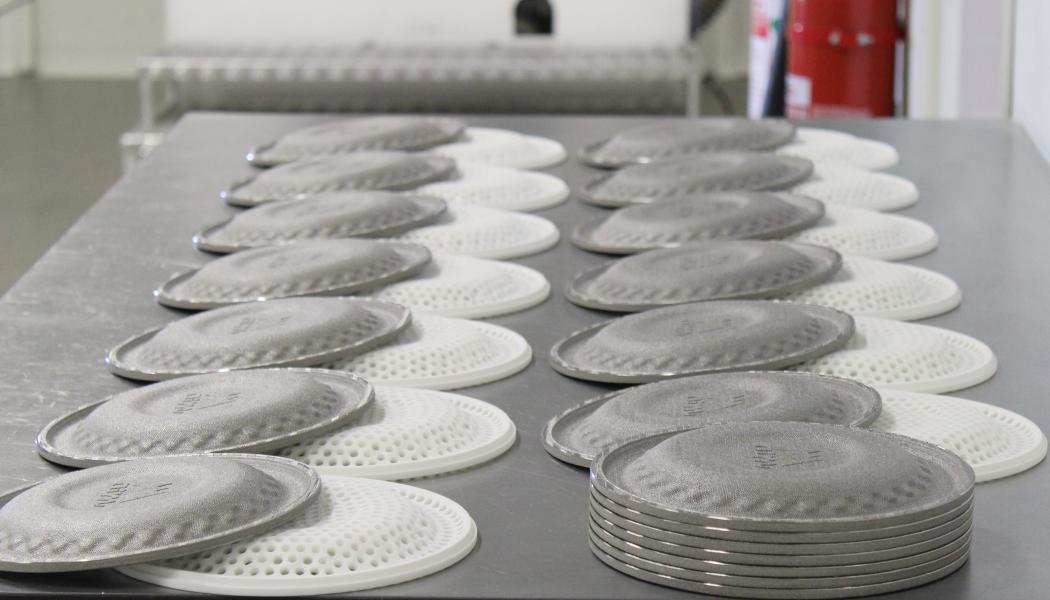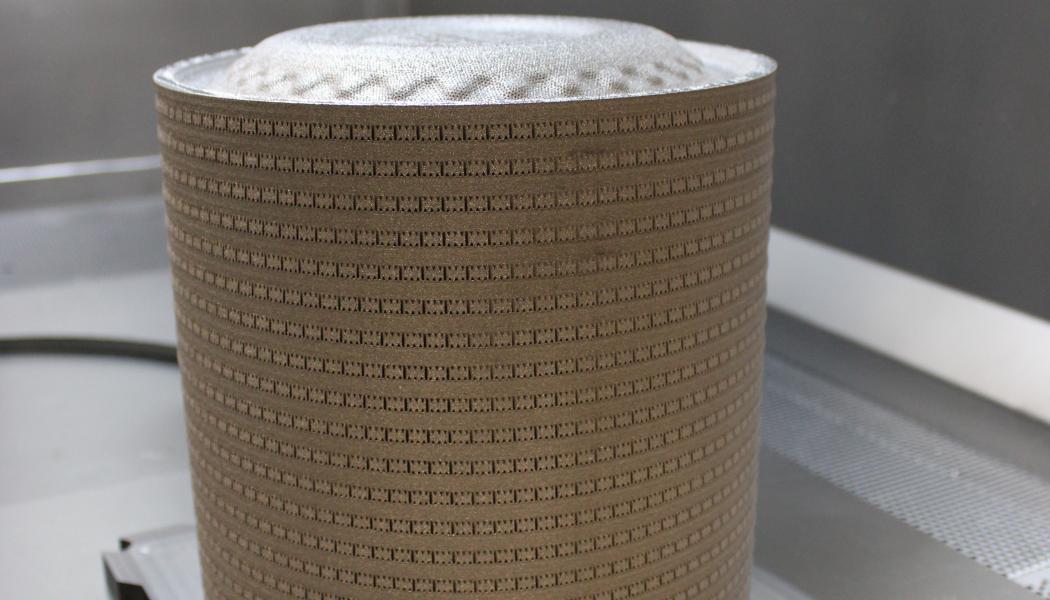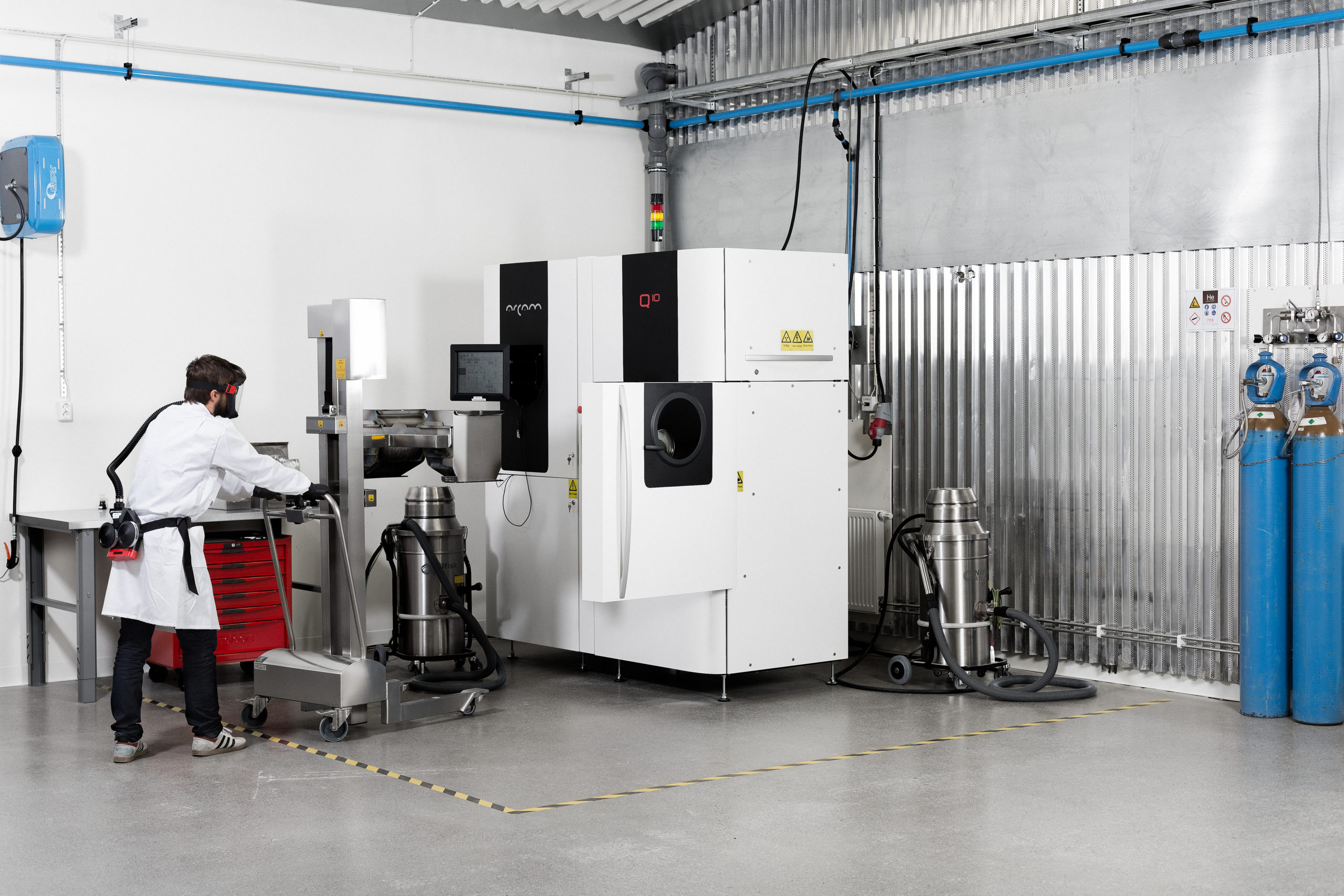A team of researchers and engineers at medical and industrial component manufacturer AIM Sweden have been leveraging GE Additive’s 3D printing technology to manufacture sustainable paper food and drink containers from renewable cellulose fibers for a range of new uses, such as pressurized drink containers and durable food vessels, which are currently created using single-use plastics.
A commercial spin-off from the Mid Sweden University in Östersund, AIM Sweden is relying on electron beam melting (EBM) technology to create products with complex structures in its quest to reimagine the future of manufacturing for the good of the planet. Over the past five years, the innovative company has used its expertise and three GE Additive systems to develop cutting-edge 3D printed perforated molds that address the unique challenges of turning wet, fibrous pulp into next-generation molded fiber containers with improved strength, thinner walls, and the ability to contain liquids and fats.
These new 3D printed tooling concepts as well as methods to model and produce them have piqued the interest of the pulp and packaging industry, which is looking for new solutions that can solve wider environmental challenges. Molded fiber packaging has already emerged as an ideal eco-friendly and biodegradable solution for both primary and secondary packaging in food and beverage and consumer durable electronic goods, and AIM Sweden is looking to potentiate the manufacturing process.

One build many tools, creating the 3D printed tooling solution for molded fiber containers. Image courtesy of AIM Sweden
Consumers, organizations, and countries around the world are already steering consumption habits in a more sustainable direction and governments increasingly look to regulation to help clean up the environment. Especially considering that, currently, the world produces over 380 million tons of plastic every year, 50% of which is for single-use purposes and this is expected to double again over the next 20 years. Plastic packaging is the largest application, currently representing 26% of the total volume of plastics used. Experts suggest that unless we severely curtail plastic production and dumping, by 2050 the oceans could have more plastic than fish, looking into a grim future with a severe environmental disaster that could become irreversible.
Plastic is impossible to avoid. It’s everywhere, in clothes, toys, containers, even chewing gum is made of plastic. Plastic is not only inevitable today, but is near impossible to recycle, ending up in landfills or burned in incinerators, and becoming a major source of air pollution. But more recycling won’t solve the plastic pollution, and switching from one packaging to another won’t do the trick either.
Instead, fiber-based products are being considered a real alternative as they are based on renewable raw materials, are recyclable, and can be composted, so they don’t end up littering the marine environment. However, to date, they have not been able to deliver the rigidity, impermeability, and cost competitiveness of their plastic counterparts. In fact, in the manufacturing process of molded fiber products, it is necessary to frequently stop the production line for maintenance. For example, the forming tools needed to produce common egg trays easily clog, requiring frequent cleaning and repair, leading to significant production downtime. Additionally, producing conventional molds requires a substantial amount of manual operations and workmanship, making it time-consuming, and expensive.
With the support of GE Additive’s EBM machines to produce the molds, AIM Sweden has the potential to become a game-changer in the consumer goods packaging industry. The company’s new 3D printed shaping tools are cheaper, more efficient, and have a longer life expectancy.
AIM’s technical director Axel Bergström said it all started after a few customers began asking about forming tools for molded fiber. The company made early molds that were fully functional but were soon challenged to improve the functionality by increasing resolution and making even smaller perforation holes that were more evenly distributed.
“To increase the resolution of perforation across a complex 3D surface was a geometric challenge that pushed the limits of current additive printing technology and knowhow,” described Bergström. “The GE Additive team in Gothenburg provided an advanced training course which was instrumental for the process development work we later carried out. Now, we can utilize our EBM machines more efficiently and build high resolution titanium skins more or less free of support.”
The collaboration has allowed AIM Sweden to develop a completely new tooling solution as well as an optimized EBM build strategy to produce extremely thin, highly stackable molds with minimal or no support structures, reducing production time significantly. But this is only the beginning, the company indicated that these molds now make it viable to design and optimize porosity on a hole by hole basis, including position, size, shape, and angle at a consistent quality, allowing the molded fiber to be used in ways never thought possible.
Like most additive technologies, EBM is a sustainable and energy-efficient process that, compared to conventional techniques, cuts down on waste by only using the materials needed. Already active and experienced in the manufacture of metal and plastic orthopedic and industrial components, AIM Sweden has been using GE Additive Arcam EBM systems – the Q20plus and Q10plus – to manufacture medical and industrial components in metal and plastics. Now, they’re being used to develop the firm’s new tooling concept for the production of next-generation molded fiber containers designed to have a positive impact on the environment.
“Imagine if we could change all the coffee cups in the world to be made from renewable cellulose fibers,” pondered Stefan Thundal, Chief Commercial Officer at AIM Sweden. “Until now this has been a bit of a pipe dream, but we have more and more evidence that our additive manufactured tools for molded fiber products have significant advantages over traditional tooling. With our solution we also see the opportunity to retrofit existing production lines with 3D printed forming tools, reaching a broader range of customers. And coffee cups would just be the start. Every little bit helps us all become more sustainable.”
Subscribe to Our Email Newsletter
Stay up-to-date on all the latest news from the 3D printing industry and receive information and offers from third party vendors.
You May Also Like
3D Printing Financials: Fathom Struggles in Financial Quicksand During Critical Transition
Facing a year of key transitions and financial pressures, Fathom (Nasdaq: FTHM) has filed its annual report for 2023 with the U.S. Securities and Exchange Commission (SEC). The document outlines...
Latest Earnings Overview for Australian 3D Printing Firms Titomic and AML3D
Australian 3D printing manufacturing firms Titomic (ASX: TTT) and AML3D (ASX: AL3) reported their financial results for the period from July to December 2023, marking the first half of their...
3D Printing Webinar and Event Roundup: April 7, 2024
Webinars and events in the 3D printing industry are picking back up this week! Sea-Air-Space is coming to Maryland, and SAE International is sponsoring a 3D Systems webinar about 3D...
3D Printing Financials: Unpacking Farsoon and BLT’s 2023 Performance
In the Chinese 3D printing industry, two companies, Farsoon (SHA: 688433) and Bright Laser Technologies, or BLT (SHA: 688333), have recently unveiled their full-year earnings for 2023. Farsoon reported increases...

































